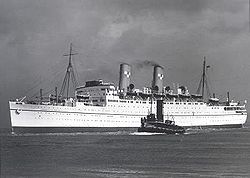Alsatian
|
||||||||||||||||||||||
|
||||||||||||||||||||||
|
||||||||||||||||||||||
|
||||||||||||||||||||||
|
||||||||||||||||||||||
The Alsatian was an ocean liner put into service in 1914 by the British-Canadian shipping company Allan Line , which was used in the North Atlantic passenger and freight traffic between Great Britain and the USA . She and her identical sister ship the Calgarian were the largest ships of their shipping company and the last to be built for the Allan Line. They were the largest steamers to cross the St. Lawrence River in their day . During the First World War , the ship served as an armed auxiliary cruiser . In 1917 the Alsatian was transferred to the Canadian Pacific Steamship Company's fleet , which took over the Allan Line. From then on, the ship went under the name RMS Empress of France . In 1934 it was scrapped in Dalmuir, Scotland. In 20 years of service, the ship made 99 Atlantic crossings, five Pacific voyages and eight cruises .
Allan Line
The 18,481 gross registered tons (GRT) steamship Alsatian was built in 1912-13 at the William Beardmore and Company shipyard in Dalmuir, Scotland, near Glasgow . The 174.16 meter long and 22.07 meter wide Alsatian was launched on March 22, 1912 and was completed at the end of 1913. She had an identical sister ship , the Calgarian (17,515 GRT), which was completed shortly after her. The two modern transatlantic steamers were the largest and most luxurious ships that Allen Line ever put into service and at the same time the last before the shipping company was taken over by the Canadian Pacific Steamship Company in 1917 . The Alsatian had two masts , two funnels and four propellers . She could make a speed of up to 18 knots. The Alsatian was the first transatlantic steamer to be fitted with a stern that was more common for cruise ships . It was equipped with equipment for wireless communications and for tracking down submarines .
In the passenger quarters there was space for 287 passengers in the first, 504 in the second and 848 in the third class. The passenger cabins were equipped with heating and ventilation systems. The spacious and comfortably furnished lounges of the first class, including the lounge , the library , the writing room and the smoking room, were located on the A-deck . The veranda café and the gymnastics room were also found on the upper promenade deck .
On January 17, 1914, ran Alsatian in Liverpool for their maiden voyage to Saint John from. On May 22, 1914, she made her first crossing from Liverpool to Quebec . She ran for the last time on this route on July 17, 1914. On August 7, 1914, the Alsatian was declared an Armed Merchant Cruiser (armed auxiliary cruiser) and assigned to the 10th Cruiser Squadron, which patrolled the Shetland Islands . She became the flagship of Rear Admiral Dudley de Chair and later Admiral Sir Reginald Tupper and was one of the first ships to be equipped with a device for wireless direction finding .
Canadian Pacific

When the 10th Cruiser Squadron was decommissioned in 1917, the Alsatian became the property of the Canadian Pacific Steamship Company, which had bought the Allan Line. She left Liverpool for Canada on September 28, 1918 on her first voyage for the new owners. After the second voyage, the ship was retreaded in Glasgow. On April 4, 1919, the ship was renamed the Empress of France and on September 26 of the same year it left Liverpool for its first voyage under the new name to Quebec.
On May 3, 1922, the first crossing started on the Southampton - Cherbourg - Quebec route and on May 31, 1922 on the Hamburg - Southampton - Cherbourg - Quebec route. In 1924 there was a change from coal to fuel combustion and in July 1926 the tourist class was added to the previous three passenger classes. In January 1927, the second class was abolished. On September 29, 1927, the Empress of France ran for the last time in Hamburg . On October 31, 1928, the Empress of France found itself on an entirely new route when it first sailed from Southampton to Suez , Hong Kong and Vancouver . The last Atlantic crossing from Southampton to Cherbourg took place on September 2, 1931. Immediately afterwards it was placed on the Clyde . On October 20, 1934, the former Alsatian was scrapped in Dalmuir.
Web links
- Summary of the ship's description in The Ships List (approximately in the middle)
- More information and pictures
